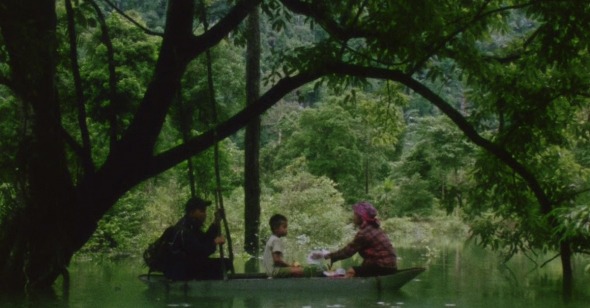The Language of Film
By Đăng Tùng Bạch
New York Film Festival 2025:
Hair, Paper, Water…
Dir. Trương Minh Quý and Nicolas Graux, Belgium/France/Vietnam, no distributor
Cao Thị Hậu was born 60 years ago in a cave. She was delivered a few months early, in her own words, and lived inside the cave with her family until she was two. Now, she dreams of her mother calling her back to the cave where she was born, where she first knew what “home” was. Like the memories that flow from her to her descendants in her fading language of Rục, water trickles inside the dark caves, drop by drop, leaving echoes that lead Mrs. Hậu home.
Hair, Paper, Water… is, in some ways, a follow-up to co-director Trương Minh Quý’s ethnographic docufiction film The Tree House (2019), which also features Mrs. Hậu. In The Tree House, the observation of several ethnic minority groups in Vietnam’s Central Highlands is framed by Trương Minh Quý’s narration as a filmmaker from the future now living on Mars, which offers sporadic commentary that ranges from self-reflections about Trương’s identity as an ethnic-majority outsider to curiosities about the language of cinema and the languages spoken by the documentary participants. Hair, Paper, Water…, however, strips away all the quasi-documentary eccentricities of its predecessor and adopts a plain-spoken voice. Co-director Nicolas Graux employs an innocent gaze with his cinema-vérité cinematography to follow the daily lives of Mrs. Hậu and her grandson. Shot on vintage Bolex cameras, the richly textured 16mm images emerge with the lightness of simplicity, which so charmingly mirrors the candid vignettes they capture. With such candor, Hair, Paper, Water… becomes a gentle and intimate portrait of Mrs. Hậu that is radiant with an enveloping warmth.
Every shot Graux captures is delicately imbued with an ephemeral fragrance. In a soft, wordless tableau, sheer blue curtains are caressed by breezes. In another, Mrs. Hậu walks briskly on a dirt road when a stray dog, wagging its tail, comes up to follow behind her. As the drowsy sky drapes its veil of rain upon rustling treetops, the leaves and serene mountain springs cast a hypnotic glow. A small boy dances around a shed on his bare feet, his eyes smiling cheekily between the wooden planks. Later, the boy, now older, walks steadily as clouds of mist settle around him. He eagerly shares his dream of caring for his mother and grandmother, then speaks plainly of his father’s drunken bouts of rage. Silently, the mist descends. Time has encroached on the young playful boy. Clumsily but enthusiastically, he reads out words in Vietnamese and English picture books.
But what of Rục, his mother tongue, which every day faces the danger of disappearing forever? Mrs. Hậu recounts a myth from her culture about an ancestor who, in order to preserve his language, has written it down onto a piece of animal hide. However, the piece of hide is eaten by wild animals, making Rục a language without a written form. The language of cinema thus appears to have set out to preserve Rục. Hair, Paper, Water… begins and ends with sequences of Mrs. Hậu reading Rục words out loud. Vietnamese texts, in red, corresponding to Rục words she speaks, appear against images of what she is describing. The film becomes a picture book, just like the ones Mrs. Hậu’s grandson reads from. The boy, curled up in Mrs. Hậu’s arms, meekly repeats after her as the little boat they are on rocks gently to the river currents. Mrs. Hậu patiently teaches her grandson a Rục word he has trouble pronouncing while the river beckons them into the embrace of a cave, whose rock faces glisten in the dark. As the film reaches its solemn ending, it offers a glimpse into the future of Rục peoples, whose faint promise rests on the shoulders of younger generations.
While Hair, Paper, Water… sheds light on the vulnerability of the Rục language, the film’s materiality also suggests the fragility of cinema. Trương’s editing retains light leaks and other blemishes to underscore the film’s analog identity, as if to preserve it. Not only does shooting on film with a vintage camera embody the act of remembering that occurs throughout the film, it also creates physical copies of the memories captured in the form of celluloid filmstrips. And while these filmstrips can capture a language better than a piece of animal hide, they might also one day be wiped away, lost in the ether of the digital age.
